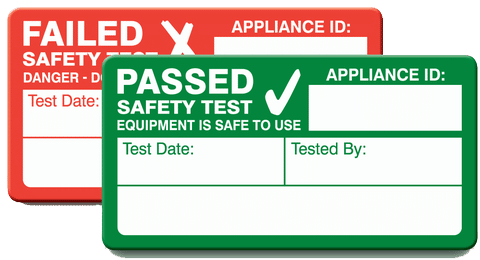PAT Testing
Click here to book online now
Get a quote
Request a free remote quote
PAT Testing
Your local experts
Portable Appliance Testing (PAT)
At MJP Electrical, all our engineers are trained to City & Guilds 2391 Inspection and Testing Level, specifically for the periodic testing and inspection of electrical equipment.
Therefore, we are able to carry out periodic PAT tests on all of your electrical appliances to ensure that they comply with the electrical regulations and are safe to use. Failure to test equipment regularly could lead to electrical safety problems due to faulty wiring or appliance faults which, if not attended to, could lead to injury or even death.
Don’t compromise on your electrical safety. Get in touch to find out about our PAT testing services.


FREE Download
Download our FREE Guide - Why do I need to PAT test my business?
Our guide covers what is meant by a PAT test, reasons for having the electrical appliances in your business tested, the safety implications of using dangerous appliances and your legal obligations as a business owner.
Take a look at your free guide, Why do I need to PAT test my business? today.

Reviews
Hundreds of happy customers
- Electrician came very promptly, within a couple of hours of my talking to the company. He was courteous, friendly, and very helpful, doing an extra task over and above the job I had postedread moreread less
 Sally Millward4/27/2024Small job replacing a cooker switch. Very professional job sorted within the hour very impressed, would definitely recommendread moreread less
Sally Millward4/27/2024Small job replacing a cooker switch. Very professional job sorted within the hour very impressed, would definitely recommendread moreread less Jenny Geddes4/24/2024
Jenny Geddes4/24/2024 - Full rewiring now completed and we couldn't be more pleased. Very professional and efficient. Couldn't fault anything, a very high quality job. Respectful of property and mess minimal considering scale of job. Always punctual with excellent communication. Special thanks to Ross and Dan who are exceptional. Thanks also to Ash and Laurie for continual updates, and to Mark who should be very proud of his business. Highly recommend this company.read moreread less
 val osborne4/23/2024Great service! Really friendly and did a great job! Spoke to the a member of the company who was able to give me a detailed quote and Greig fixed our issue super fast when we came out.read moreread less
val osborne4/23/2024Great service! Really friendly and did a great job! Spoke to the a member of the company who was able to give me a detailed quote and Greig fixed our issue super fast when we came out.read moreread less Sophia Antoniou4/19/2024
Sophia Antoniou4/19/2024 - Very happy with MJP. Booking process was easy and efficient and Connor did a great job.read moreread less
 John Cowen4/19/2024Fantastic service from start to finish.read moreread less
John Cowen4/19/2024Fantastic service from start to finish.read moreread less Marc Menear4/18/2024
Marc Menear4/18/2024 - Great service, Jon was really helpful and his work was exceptional. Really pleased.read moreread less
 Chris Elliott4/17/2024Very competent company which employs excellent engineers. Thank you.read moreread less
Chris Elliott4/17/2024Very competent company which employs excellent engineers. Thank you.read moreread less David Cryer4/12/2024
David Cryer4/12/2024 - Excellent service in carrying out a few electrical jobs around the house. Quick and efficient response and contact at every stage, definitely recommend and will use again in the future. Many thanksread moreread less
 Sophie Kavanagh4/06/2024Efficient service . Informative and attentive. Chris was very polite and professional.read moreread less
Sophie Kavanagh4/06/2024Efficient service . Informative and attentive. Chris was very polite and professional.read moreread less Julie Coulson4/05/2024
Julie Coulson4/05/2024 - Efficient and friendlyread moreread less
 Anna Keen4/05/2024Great response time and very professional. Would highly recomendread moreread less
Anna Keen4/05/2024Great response time and very professional. Would highly recomendread moreread less kelly waller3/26/2024
kelly waller3/26/2024 - Very quick response time, extremely polite and professional, excellent work, problem identified and solved in less than an hour and everything left tidy and orderly. All this on a Sunday morning! Great work and I will happily use them again.read moreread less
 Teresa Patten3/24/2024Top service as always, thank you.read moreread less
Teresa Patten3/24/2024Top service as always, thank you.read moreread less Kirstin West3/21/2024
Kirstin West3/21/2024 - Quickly and competently done I would recommend this company for similar home electrical workread moreread less
 robert stenner3/20/2024Great job! The young gentleman Dan provided a very kind and professional service, do appreciate it!read moreread less
robert stenner3/20/2024Great job! The young gentleman Dan provided a very kind and professional service, do appreciate it!read moreread less Yong Sun3/20/2024
Yong Sun3/20/2024 - Booked online turned up on time quoted , did what they said more than I can say with my experience with most sparkysread moreread less
 Ry Peake3/19/2024Quick response, excellent, professional electrical work. Solved problem. Thank you.read moreread less
Ry Peake3/19/2024Quick response, excellent, professional electrical work. Solved problem. Thank you.read moreread less Caroline3/15/2024
Caroline3/15/2024 - An excellent service. Great communication between the company and ourselves. We needed items PAT testing, this was done very efficiently. Polite friendly staff. Definitely recommend.read moreread less
 TIA HARRIS3/15/2024As trade companies go, they were very customer centric. Commutation was great and speed even better. Appreciate the emergency help.read moreread less
TIA HARRIS3/15/2024As trade companies go, they were very customer centric. Commutation was great and speed even better. Appreciate the emergency help.read moreread less Tom Kavanagh3/15/2024
Tom Kavanagh3/15/2024
Frequently asked questions
Let us answer your important questions
A: Portable appliance testing (PAT) is the term used to describe the examination of electrical appliances and equipment to ensure they are safe to use. Most electrical safety defects can be found by visual examination but some types of defect can only be found by testing. However, it is essential to understand that visual examination is an essential part of the process because some types of electrical safety defect can’t be detected by testing alone.
A: There is currently no strict legal requirement for PAT testing. The Government however has put regulations into place that pertain to the maintenance of electrical appliances and the most effective way to ensure that these regulations are met is through PAT testing.
The UK Health and Safety Executive along with insurance companies will expect you to perform PAT testing to ensure that you are compliant with certain regulations including:
- Health and Safety at Work Act of 1974
- The Electricity at Work Regulations of 1989
- The Provision and Use of Work Equipment Regulations of 1998
- The Management of Health and Safety at Work Regulations of 1999
Not complying with the above mentioned regulations can result in fines up to £5,000 and/or six months imprisonment. Fines have been seen to go as high as £20,000 and offences heard in the Crown Court have carried sentences of more than 2 years imprisonment in additional to unlimited financial penalties. So even though PAT testing itself is not legally required, it simply helps you to protect yourself by ensuring that you are complying with these regulations.
Claims that PAT testing is required by law and that the client is breaking the law by not having it done are simply not true. The law does require however that employers, including self-employed, ensure that all electrical equipment that they provide in their business is safe and properly maintained. This means that PAT testing is a critical part of your company’s health and safety and should be considered part of a solution to your safety concerns.
PAT testing provides the most effective way to identify defects that can come with use. Faults in electrical equipment pose a potential hazard, particularly if they are not repaired readily. Even though PAT testing itself is not required by law, the consequences of electrical faults should be considered carefully.














